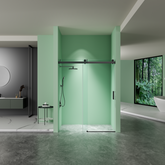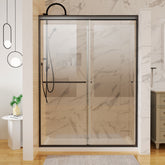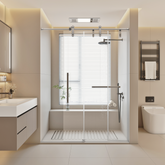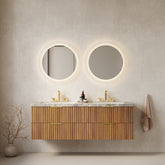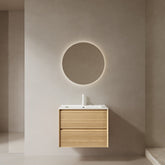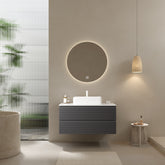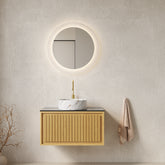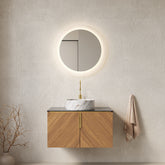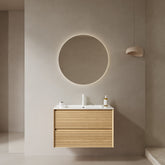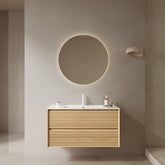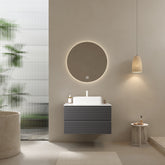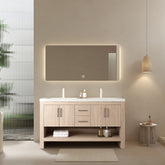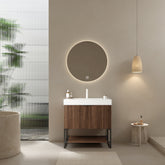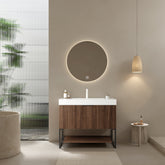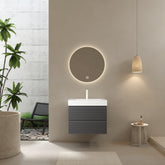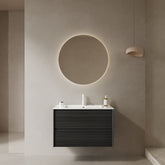Best Materials for Bathroom Vanities: MDF, Solid Wood, or Plywood?
Introduction
When choosing a bathroom vanity, the material is just as important as the design. With constant exposure to moisture, heat, and daily wear, selecting the right material ensures durability, functionality, and long-term aesthetics. But with so many options available, how do you decide?
In this article, we’ll compare three of the most common bathroom vanity materials—MDF, solid wood, and plywood. Each has its strengths and weaknesses, from affordability and moisture resistance to premium aesthetics and durability. Whether you're a homeowner planning a renovation or a business looking for the best material to stock, this guide will help you make an informed decision.

1. MDF (Medium-Density Fiberboard) for Bathroom Vanities
What is MDF?
MDF, or Medium-Density Fiberboard, is an engineered wood product made by compressing wood fibers with resin under high pressure. It has a smooth, uniform surface, making it a popular choice for bathroom vanity construction, especially for painted finishes.
Pros:
- Affordable and budget-friendly – MDF is one of the most cost-effective bathroom vanity materials, making it ideal for those looking for style on a budget.
- Smooth surface for painting and finishing – Its even texture allows for a sleek, flawless paint application, perfect for modern designs.
- Resistant to warping under normal conditions – Unlike solid wood, MDF doesn’t expand or contract as much with temperature changes.
Cons:
- Prone to swelling in high moisture environments – If water seeps into unsealed edges, MDF can absorb moisture and swell, making it less suitable for humid bathrooms.
- Not as durable as solid wood or plywood – While MDF holds up well for everyday use, it’s not as strong or long-lasting as solid wood or plywood, especially in high-traffic areas.
MDF is a great choice for those prioritizing affordability and a smooth finish, but it requires proper sealing and maintenance to ensure longevity in a bathroom setting.

2. Solid Wood for Bathroom Vanities
What is Solid Wood?
Solid wood is exactly what it sounds like—natural, pure wood without fillers or adhesives. It’s a top choice for bathroom vanities due to its strength, timeless appeal, and ability to be refinished over time. However, in a high-moisture environment like a bathroom, proper care is essential to maintain its beauty and durability.
Pros:
- Premium, natural appearance – Solid wood adds warmth and elegance, making it a favorite for high-end bathroom designs.
- Highly durable and long-lasting – When properly maintained, a solid wood bathroom vanity can last for decades.
- Can be refinished multiple times – Unlike MDF or plywood, solid wood can be sanded and refinished to refresh its look or repair surface damage.
Cons:
- Expensive compared to MDF and plywood – The cost of solid wood is significantly higher, making it a luxury choice.
- Susceptible to moisture-related expansion and contraction – Wood naturally expands and contracts with humidity changes, which can lead to warping if not properly sealed.
- Requires proper sealing and maintenance – To prevent water damage and extend its lifespan, solid wood vanities need protective coatings and regular upkeep.
For those who prioritize aesthetics and longevity, solid wood is an excellent investment—but it does require extra care to keep it looking its best in a bathroom setting.

3. Plywood for Bathroom Vanities
What is Plywood?
Plywood is an engineered wood product made by layering thin sheets of wood veneer and bonding them with adhesive. This cross-grain construction gives it superior strength and moisture resistance, making it a reliable choice for bathroom vanities.
Pros:
- Strong and moisture-resistant – Plywood holds up well in humid bathroom environments, making it less prone to warping than solid wood.
- More stable than solid wood in humid environments – Unlike solid wood, plywood expands and contracts less with temperature and moisture changes.
- Cost-effective alternative to solid wood – While more expensive than MDF, plywood offers a great balance of durability and affordability.
Cons:
- Higher cost than MDF – Although cheaper than solid wood, plywood is still pricier than MDF, which might be a consideration for budget-conscious buyers.
- Edges may require finishing for a polished look – Since plywood has exposed layers, it often needs edge banding or veneer for a smooth, finished appearance.
For those looking for a durable, moisture-resistant, and cost-effective material, plywood is a smart choice that outperforms MDF in durability while being more affordable than solid wood.

4. Comparing MDF, Solid Wood, and Plywood: Which is Best?
Each material has its strengths, so the best choice depends on your priorities.
- Durability: Solid wood is the most durable, lasting for decades with proper care. Plywood follows closely, offering great strength, while MDF is the least durable.
- Moisture Resistance: Plywood performs best in humid environments, resisting warping better than solid wood. MDF is the most vulnerable to moisture damage.
- Cost-effectiveness: MDF is the most budget-friendly, making it ideal for affordable bathroom vanities. Plywood strikes a balance between price and performance, while solid wood is the most expensive.
- Aesthetics & Customization: Solid wood stands out for its premium, natural look and ability to be refinished. Plywood offers a good balance of appearance and function, while MDF is best for painted finishes.
Ultimately, if you want luxury and longevity, solid wood is the way to go. For a balance of durability and affordability, plywood is a solid choice. And if budget is the main concern, MDF offers a smooth, stylish option at a lower cost.

5. Choosing the Right Material Based on Your Needs
Selecting the best material for your bathroom vanity depends on your priorities—budget, durability, or aesthetics.
- For budget-conscious homeowners: MDF is the most affordable option, offering a smooth surface for painted finishes, but it requires proper sealing to prevent moisture damage.
- For premium quality and luxury appeal: Solid wood delivers a timeless, high-end look with unmatched durability, but it comes at a higher price and needs regular maintenance.
- For durability in high-moisture areas: Plywood is the best choice, balancing strength, moisture resistance, and affordability, making it ideal for bathrooms with high humidity.
No matter your choice, ensuring proper sealing and care will help extend the lifespan of your bathroom vanity, keeping it both functional and stylish for years to come.

Conclusion
Choosing the best material for a bathroom vanity comes down to balancing cost, durability, and aesthetics. MDF is the most budget-friendly but requires extra care in humid environments. Solid wood offers a luxurious, long-lasting option but needs proper maintenance. Plywood provides the best moisture resistance and durability, making it a practical middle ground.
For those on a tight budget, MDF is a great choice. If premium quality and timeless appeal matter most, solid wood is worth the investment. And for high-moisture areas, plywood delivers the best performance. Ultimately, selecting the right material ensures your bathroom vanity remains both stylish and functional for years to come.
Featured Products
60" Bathroom Vanity with Sink, Wall-Mounted Bathroom Storage Cabinet with Drawers
- 2,075.00USD
- 2,075.00USD
- Unit price
- / per
30" Wall-Mounted Bathroom Vanity with Ceramic Sink
- 691.00USD
- 691.00USD
- Unit price
- / per
24" Wall-Mounted Bathroom Vanity with Ceramic Sink
- 566.00USD
- 566.00USD
- Unit price
- / per
36" Floating Bathroom Vanity with Vessel Sink
- 783.00USD
- 783.00USD
- Unit price
- / per
30" Wall-Mounted Bathroom Vanity with Sink
- 691.00USD
- 691.00USD
- Unit price
- / per
30" Modern Wall Mounted Bathroom Vanity with Sink
- 585.00USD
- 585.00USD
- Unit price
- / per
30" Floating Bathroom Vanity with Sink
- 628.00USD
- 628.00USD
- Unit price
- / per
36" Wall-Mounted Bathroom Vanity with Ceramic Sink
- 726.00USD
- 726.00USD
- Unit price
- / per
30" Bathroom Vanity with Vessel Sink, Gray Color
- 720.00USD
- 720.00USD
- Unit price
- / per
36" Modern Bathroom Vanity, Wall-Mounted, Natural Walnut Woodgrain Color
- 770.00USD
- 770.00USD
- Unit price
- / per
60" Bathroom Vanity with Sinks, Freestanding Oak Woodgrain Color
- 1,513.00USD
- 1,513.00USD
- Unit price
- / per
30" Freestanding Bathroom Vanity with Sink, Retro Walnut Woodgrain Color
- 865.00USD
- 865.00USD
- Unit price
- / per
36" Freestanding Bathroom Vanity with Sink, Retro Walnut Woodgrain Color
- 920.00USD
- 920.00USD
- Unit price
- / per
24" Bathroom Vanity with Undermount Sink, Gray Color
- 690.00USD
- 690.00USD
- Unit price
- / per
36" Wall-Mounted Bathroom Vanity with Ceramic Sink, Dark Oak Woodgrain Color
- 770.00USD
- 770.00USD
- Unit price
- / per
